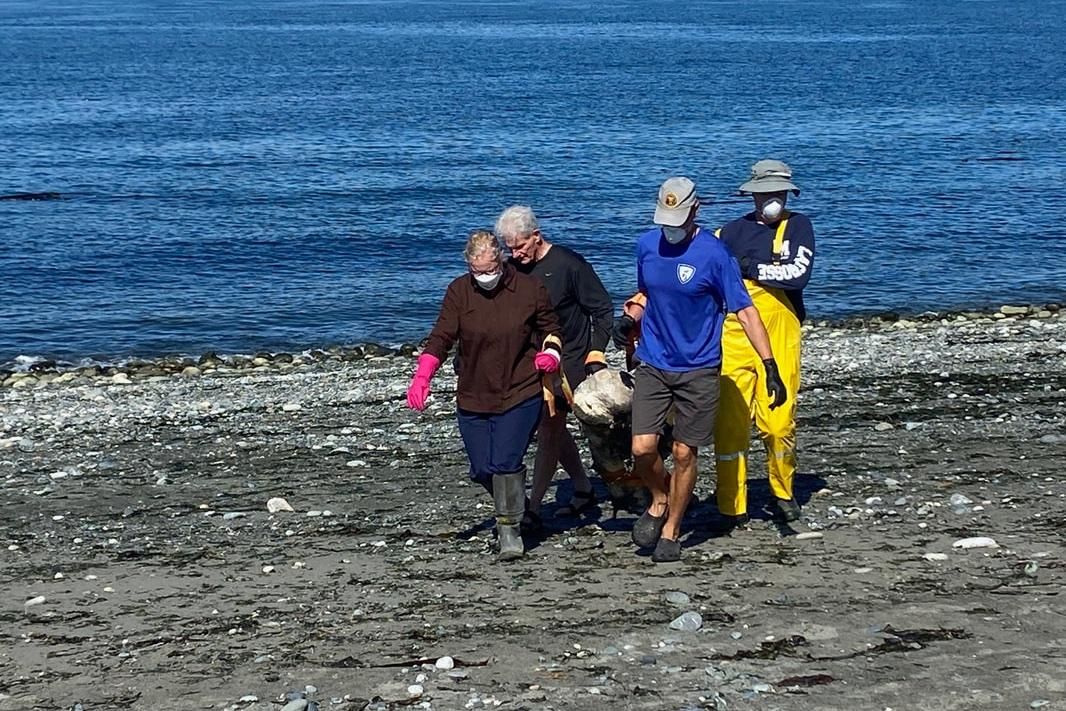I love walking the beach. The sea air. The salt breeze. Sun on my face, and the overwhelming stench of 45 tons of rotting whale on the shore.
We’d rather see them splashing, blowing and diving, but this one expired and floated around for three weeks before it came to rest at Camp Casey allowing easy access for volunteers to participate in its deboning. Jake Carlson, the director of Camp Casey, got authorization from NOAA to become stewards of this carcass and coordinated the effort. A team of professionals led the operation. Jessie Huggins and Andi Gero from Cascadia Research Collective and Whidbey’s retired federal wildlife biologist, Matt Klope, brought their expertise.
I arrived as four volunteers were hauling a large bone off the beach. Behind them a crowd was busy around the 45 foot carcass. I’d been invited by my friend, Betsy, from the Port Townsend Marine Science Center. “This will take a small army,” she’d said, and that’s what they got. She’d help prepare a grey whale skeleton named Gunther for display on a Port Townsend dock. On Whidbey we have Rosie hanging from the ceiling at the Coupeville Wharf. This one will be displayed at Camp Casey, eventually.
Deb came from Tacoma and stepped into the fray with her hip waders and rubber boots. I recognized volunteers from Sound Waters Stewards and Friends of Whidbey State Parks. Jake and other YMCA staff were fully involved. A team of three sat to one side sharpening knives. Young UW marine biology students were tagging the rib bones. An Environmental Science teacher from Missouri, had college students from across the country staying at the Pacific Rim Institute. He brought his class to work on the whale. I spoke with one from Ohio and another from Ontario.
The spine stood out and ribs twisted around as they worked to cut the meat from the bone. The blubber floats and may wash up at the nearby campground attracting varmints and smelling to high Heaven. So, helpers pulled the soft parts and stashed them behind a wall of driftwood to rot. The bones were taken off-site to be buried in a pile of horse manure where millions of tiny carnivores, given several months, will clean them up. Then they’ll be bleached by the sun and finally reassembled for display.
As she worked, Jessie gave lessons in whale anatomy. She and her assistants were elbow deep in the side of the whale with helpers pulling the blubber away on the far side. She finally pulled out the whale’s pelvic bone, holding it up triumphantly. She also found the chevrons from below the tail vertebrae that protect blood vessels and attach muscles. They collected any bones and bone fragments that might help rearticulate the skeleton.
Centuries ago, grey whales roamed the oceans of the northern hemisphere. But whales were highly prized for their blubber and baleen. Grey whales were hunted down until they disappeared from the Atlantic in the early 1900s.
In the Pacific, grey whales were near extinction until the 1930’s when a commercial hunting ban was adopted by the League of Nations and later reinforced by the International Whaling Commission. Then came the Marine Mammal Protection Act in 1972 and the Endangered Species Act in 1973. Conservationists worked with governments to adjust shipping lanes to avoid the 14,000 mile grey whale migration. They tracked the kinds of fishing gear that have the worst impact on marine mammals. Grey whale populations recovered in the eastern Pacific to the point that they were delisted in 1994.
However, climate change, which diminishes their food sources, and offshore oil drilling and oil exploration in the arctic still threaten grey whales. They’re critically endangered in Russian and Asian waters. Studying these amazing creatures helps us save them and pass on a conservation ethic to the next generation.
Twenty-four hours later the beach was clear. A fog rolled in and a young man from Ontario strolled the shore alone.
Thanks to the "small army" of volunteers and the biologists who brought their expertise to this project.
Camp Casey is privately owned by Snohomish YMCA who are offering new programs and breathing new life into the facility. Their pool is open to the public, during certain times, with lifeguards and swimming lessons. Some buildings are available to rent. Please call 360-678-5050 or check in at the office to see when the campus will be open for a walk. For more info click here.
Special Thanks for Betsy Carlson of the Port Townsend Marine Science Center for her valuable help on this blog. For more about what it takes to get a whale from the beach and make it into a display, visit their website and click on Whale on the Wharf here.
For more about the Cascadia Research Collective click here.
Directions
Directions: Take Highway 20 to Coupeville and turn south at the stoplight onto South Main Street. This turns into Engle Road. Drive 3.5 miles and park at the office on the right. The address is 1276 Engle Road, Coupeville.
By Bike or Bus: It’s a 3.5 mile bike ride from Main Street in Coupeville to Camp Casey with a wide shoulder. Two bikes fit on a bus bike rack, first come first served. Please wear bright clothes when riding or walking by the road. Fare Free Island Transit Route 6 stops at Camp Casey. It doesn’t run on the weekends, but you can call the day before to arrange for a free ride On-Demand. 360-678-7771. Check the schedule for weekday service here.
Trail Conditions: There is a sidewalk from the parking area to the beach. Driftwood may make beach access challenging for those with limited mobility. The beach is sand and gravel. Call ahead to ensure access. (360-678-5050)
Republished with permission. Read the original article.
